Poison hemlock seems to be on everyone’s radar more than usual this year, especially in northern Ohio. We know that while hemlock has been all over southern Ohio for years, it is continuing to spread northward, where new occurrences and observations of it may be engendering concern in the general public and local government. There have also been comments that it seems “worse than
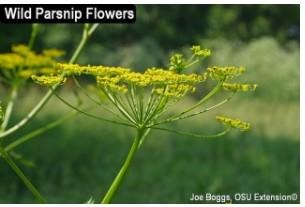
Wild Parsnip Flowers
Poison hemlock seems to be on everyone’s radar more than usual this year, especially in northern Ohio. We know that while hemlock has been all over southern Ohio for years, it is continuing to spread northward, where new occurrences and observations of it may be engendering concern in the general public and local government. There have also been comments that it seems “worse than usual” this year in some areas, and we don’t have a ready explanation for what would cause this. For any plant that reproduces by seed, an abundance of seed in one season can lead to much higher populations the following season. Seed-based population increase tends to be exponential. When left uncontrolled for several years, the populations may stay low for a few years until seed production reaches a certain level, and that amount of seed can cause a large and very observable increase in population.
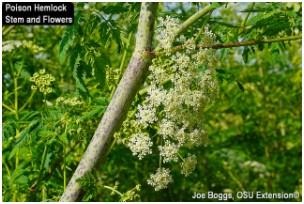
Poison Hemlock Flowers and Stem
Poison hemlock in Ohio has made the news over the past month, in articles such as this one. From a frequency of poisoning standpoint, some of these articles can make it seem worse than it is. Hemlock is in the Apiaceae or parsley plant family, which also includes wild carrot (Queen Anne’s lace), wild parsnip, cow parsnip, and giant hogweed. Giant hogweed is the truly bad actor in this group but has not become established in Ohio. All of these species share some of the same characteristics with poison hemlock to varying degrees. This comprehensive article in the OSU BYGL newsletter does a nice job of presenting information on the various species, including identification.
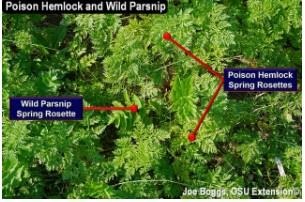
Poison Hemlock and Wild Parsnip
Poison hemlock has been in Ohio for a long time, and there are many areas it is never subject to any control measures – abandoned fields, forest borders, etc. And there are other areas hemlock grows well where it should be controlled because it reduces the quality and safety of these areas or can be seen by people. These areas include parks, roadsides, ditches, hayfields, pastures, etc. Poison hemlock is poisonous to humans and livestock, but only when ingested. Poisoning seems to be extremely rare because: 1) it’s not a plant that smells or tastes good, so animals avoid it; and 2) humans are not prone to wandering down roadsides eating plants, especially the ones that do not appear appealing. Contact with hemlock can also cause skin and eye problems which are way more likely than internal poisoning. The severity of this response varies depending upon the sensitivity of the individual and the degree of contact. This does not happen from a distance though – only with direct contact with plant parts or fluids from the plants. Anyone mowing or removing hemlock by hand should keep this in mind and protect themselves from skin and eye contact. Mowing large populations with open station tractors is not recommended.
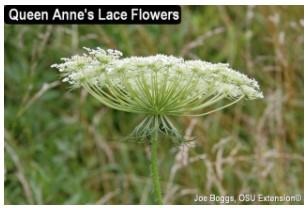
Queen Anne's Lace Flowers
Within this plant family, poison hemlock and wild parsnip present the most risk to livestock, based on the level of infestation in Ohio and toxicity. Livestock seldom eats these plants due to strong odor and taste, and most problems occur when no other forages/desirable plants are available, often during droughts. It is also possible for these weeds to inadvertently end up in hay bales where they retain toxicity. Many other plants that can have toxic effects on livestock will see those toxins dissipate during the hay drying process, or the during fermentation process if hay is ensiled or wrapped. This is not the case with poison hemlock – toxins will remain viable and lethal regardless of the curing and storage methods. All parts of the plants are poisonous with the seed heads being the most toxic. Poison hemlock contains eight piperidine alkaloids, with coniine (mature plants) and g-coniceine (young plants) being the two predominant toxic compounds. Experimental hemlock poisoning in livestock has shown a wide range of clinical signs suggesting variation in the toxic alkaloid content in the plant. Cattle eating as little as 300 grams up to 0.5 percent of body weight has shown to be fatal. Bluish discoloration of the skin from poor circulation, respiratory paralysis, and coma without convulsions are common signs before death which usually occurs within 2-3 hours after consuming a lethal dose. Wild Parsnip contains chemicals called furanocoumarins which cause severe sunburns. Housing infected livestock in shade may help reduce its effects. Other clinical signs may include acute disorders to the central nervous system or digestive tract without a fever but weakness and rapid weight loss. Other symptoms may include suddenly accelerated heartbeat, stomach, and intestinal irritation, general distress, or repeated attempts to void feces.
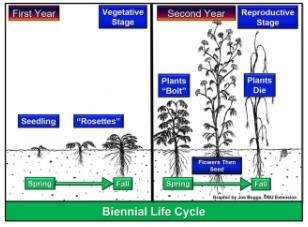
Life Stage
Poison hemlock and wild parsnip are on the Ohio noxious weed list, and therefore need to be controlled before becoming large enough to present a threat, and before seed production to prevent spread. Information on the Ohio noxious weed law can be found in this bulletin and on the OSU Farm Office page. At this time of the year when these plants are flowering, producing seed, and dying, it’s not always possible to use chemicals to control them. The goal should be getting rid of existing plants through cutting, mowing, or hand removal, and limiting production and spread of seed. The most effective timing for the application of herbicides is fall when plants are low-growing rosettes in their first year of growth, or early the following spring when plants are still small. Herbicide effectiveness ratings in Table 21 of the “Weed Control Guide for Ohio, Indiana, and Illinois”, which lists pasture and CRP herbicides. Additional products labeled for roadsides, industrial areas, etc but not shown in this guide are also effective.
Source :